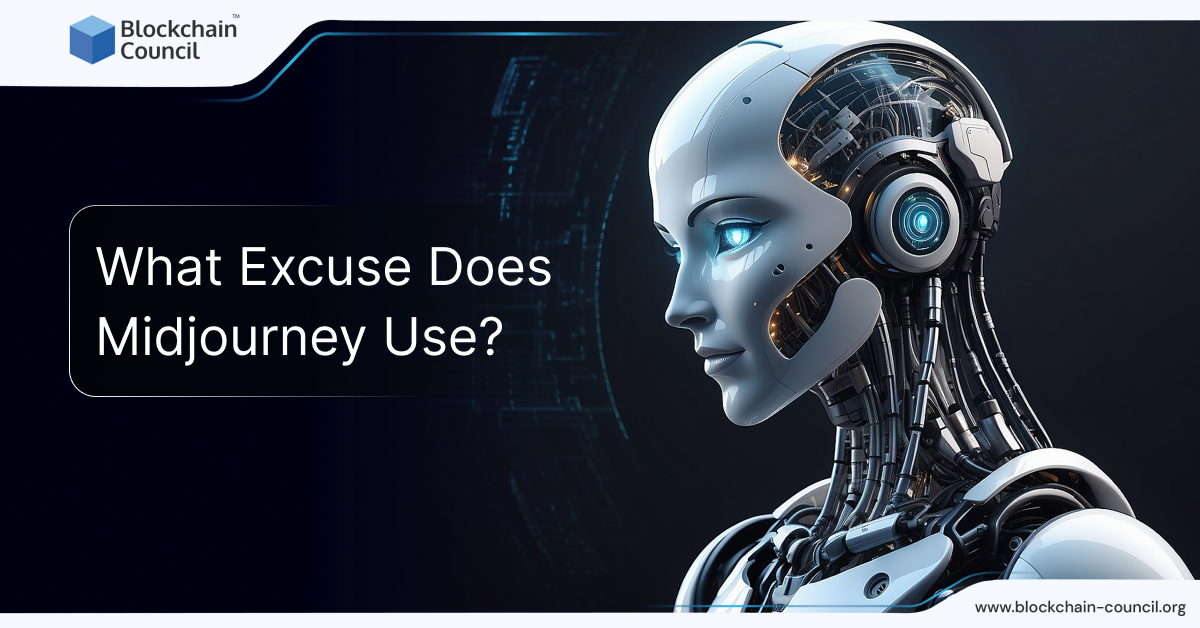
- Blockchain Council
- August 22, 2024
Midjourney, the AI-powered image generator, has brought waves to the creative world. However, this innovation has not been without its controversies.
Since its rise, Midjourney has faced several criticisms, particularly regarding its use of copyrighted materials, and its developers have had to navigate a complex web of legal and ethical challenges.
So what excuse does Midjourney use to counter the allegations?
The company’s primary defense revolves around the claim that the AI’s output is transformative and does not directly copy any specific piece of artwork.
Let’s understand the scenario in detail.
The Core of the Controversy
At the heart of the issue is the accusation that Midjourney, along with other similar AI platforms, has improperly used copyrighted artworks to train its models. Critics argue that the platform has taken liberties with the intellectual property of thousands of artists without their permission, enabling users to generate images that mimic these artists’ styles. This has led to a class-action lawsuit that includes substantial evidence against the company, such as a detailed list of around 16,000 artists whose works were allegedly used in the training data without consent.
Midjourney has been accused of essentially “scraping” these artworks from the web, feeding them into its AI to refine its algorithms. The plaintiffs in the lawsuit argue that this process infringes on the artists’ rights, allowing the creation of derivative works that could potentially flood the market with low-cost imitations, devaluing the original creations.
What Excuse Does Midjourney Use?
In response to these allegations, Midjourney has offered several excuses for its actions. Midjourney asserts that the images generated by its software are the result of complex algorithms that reinterpret and reimagine existing styles, rather than duplicating them outright.
Another defense the company has put forward is that its use of these artworks falls under “fair use,” a legal doctrine that allows limited use of copyrighted material without requiring permission from the rights holders. Midjourney argues that by transforming the input into something new and unique, it stays within the boundaries of what is legally permissible under fair use.
However, this argument has been met with skepticism. Legal experts and critics point out that the sheer scale of the data used and the direct aim of replicating specific artistic styles may push the boundaries of what can reasonably be considered fair use. Additionally, the fact that users can specifically request images in the style of known artists has fueled further criticism.
In response, Midjourney has implemented a Digital Millennium Copyright Act (DMCA) takedown policy, allowing artists to request the removal of their work from the AI’s training set. The company presents this policy as a fair compromise, enabling artists to protect their work while still allowing the AI to function and improve. However, this has not entirely quelled the criticism, leading to ongoing legal battles and class action lawsuits.
The Role of Internal Communications
Internal communications from Midjourney’s developers, which surfaced during the legal proceedings, have added another layer of complexity to the situation. These communications suggest that the company was aware of the potential legal issues associated with its training methods but proceeded anyway, perhaps underestimating the potential fallout. One particularly controversial exchange involved Midjourney’s CEO discussing how the company could potentially sidestep legal repercussions by being vague about the data sources used.
Understanding Midjourney’s Operational Framework
Midjourney operates primarily through Discord, a platform known for its community-driven features. While Discord offers a robust environment for interaction and collaboration, it also presents challenges, particularly for new users.
The complexity of navigating Discord can be overwhelming, leading Midjourney to use the platform’s familiarity as an excuse for not migrating to a more user-friendly interface sooner. This choice was initially made to leverage the existing Discord community but has been met with criticism as the user base expanded beyond tech-savvy individuals.
The recent introduction of a web application aimed at simplifying the user experience is a step forward. Yet, it still requires a Discord account, which raises questions about why Midjourney insists on this dual-platform requirement. However, Discord’s interface can be overwhelming, especially for newcomers unfamiliar with its layout.
The Focus on Discord: A Double-Edged Sword
So why does Midjourney continue to use Discord despite these challenges?
The team behind Midjourney has acknowledged that while Discord may not be the most intuitive platform for all users, it offers unparalleled community engagement. Discord allows users to share their creations instantly, receive feedback, and collaborate on projects in a dynamic, social environment. This community-centric approach is central to Midjourney’s philosophy, where creativity thrives through interaction and collective inspiration.
The company believes that the collaborative features of Discord, such as real-time feedback and community-driven learning, are critical to the user experience. However, this stance has been met with frustration by those who find Discord cumbersome or prefer a more straightforward user interface.
The Removal of Free Accounts
One of the more controversial decisions Midjourney made was the removal of free accounts. This move sparked backlash, particularly from users who relied on the free tier for occasional use or experimentation. Midjourney’s rationale behind this decision was rooted in the abuse of the service by some users who were generating inappropriate content, leading to higher operational costs and the potential for reputational damage.
Handling User Feedback and Feature Rollouts
Midjourney’s approach to feature development and rollouts has also been a topic of discussion. Users have expressed frustration over the learning curve and the sometimes abrupt introduction of new features. For example, the recent enhancements in inpainting and the introduction of zoom-out features in the upcoming 6.2 release aim to provide more control over image details, but these features also add complexity to the platform.
Conclusion
The controversy surrounding Midjourney highlights a broader conflict in the digital age: how to balance technological progress with the protection of individual rights. As AI continues to advance, these debates will likely become more frequent and intense. No matter what excuse Midjorunet uses, it serves as a cautionary tale for other AI developers, illustrating the potential pitfalls of not fully considering the legal and ethical implications of their work.
To learn how to use and develop AI models in an ethical manner, consider enrolling into industry leading certifications like the Certified Generative AI Expert™ and Certified Artificial Intelligence (AI) Developer™.





































































 Guides
Guides News
News Blockchain
Blockchain Cryptocurrency
& Digital Assets
Cryptocurrency
& Digital Assets Web3
Web3 Metaverse & NFTs
Metaverse & NFTs
